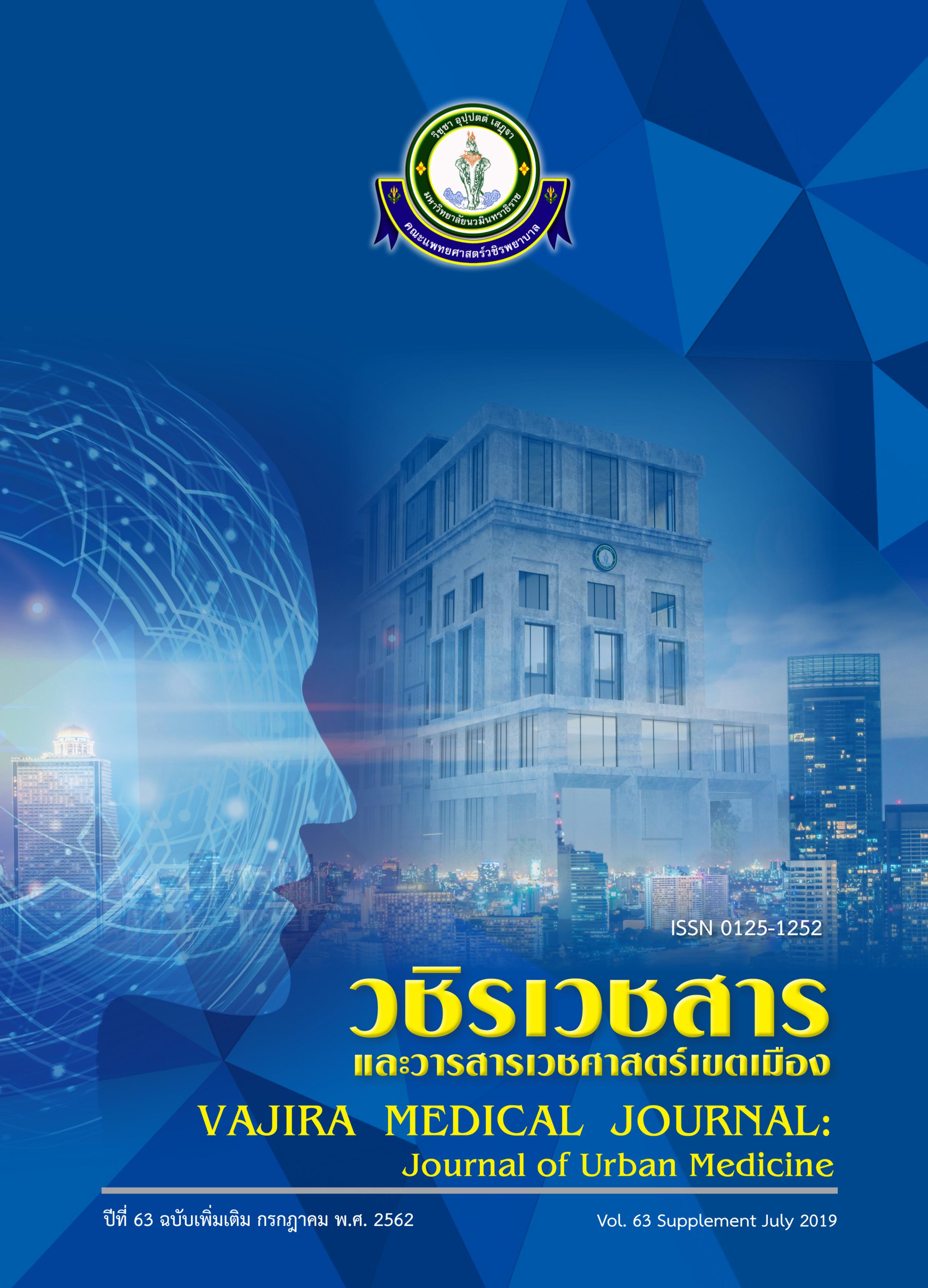Prevalence of Stress in High School Students Data Collected at Wannasorn Tower
Main Article Content
Abstract
Objective: To determine the prevalence and factors affecting stress in high school students who attend schools in Wannasorn Tower.
Method: The data was collected from 199 high school students at Wannasorn Tower on February,2nd, 2016. The questionnaire consisted of 2 parts, the first part was personal information which include age, religion, educational level, major subject, GPA, allowance, household member, siblings, birth order, family status, family income, school type, target faculty, target university, underlying disease, personal medication, sleep time, extra class hour, hobbies and their past six months experiences. This inquiry was created by researchers. And the second part was Suanprung Stress Test SPST20. After collecting the inquiries from participants, the researchers hand out brochures containing information about stress and how to handle stress to all participants. The data was analyzed by SPSS program to find percentage of frequencies, mean and examine factors affecting stress by using Chi-square test.
Result: The result shown that 105 samples ( 57.7 %) have high level of stress and 33 samples (18.1%) have severe level stress. After analyzing data by SPSS program, the factors found to be associated with stress were underlying disease, loss of their loved ones and final exams (p-value<0.05).
Conclusion: More than 50 percent of samples have higher stress than normal people. The factors found to be associated with level of stress were underlying disease, loss of their loved ones and final exams. The result of this study can be used as a guideline to plan and find solution to alleviate stress in high school students associated with factors above.
Article Details
References
2. Koyama A, Matsushita M, Ushijima H, Jono T, Ikeda M. Association between depression, examination-related stressors, and sense of coherence: The ronin-sei study. Psychiatry Clin Neurosci 2014; 68(6):441-7.
3. Department of mental health. Stress relief guideline. Bangkok. Siam M&B publishing; 1998.
4. Slitvanich S. New organization behavior: concept and theory. Bangkok: Thammasat University publishing; 2006.
5. Jinaporn N. Variables Influencing Stress of Mathayom Suksa VI Students Under The Department of General Education, Region 9. [dissertion]. Khon kaen University; 1997.
6. Chuchuay K, Playkok S, Nutadee N, Permsuwan A. Stress and quality of life of high school students in Mueang district, Chaing Mai. Bulletin of Suanprung 2010; 26(1):26-34.
7. Chonviriyakul K, Aeumteang N, Wuttipongvorachoke K. Stress in high school students in Chai Nat[Internet]. [20/12/2016]. Available from: http://www.jvkk.go.th/researchnew/qrresearch.asp?code=311390000003
8. Laipasu P, Khongsobsin D, Wannasin P, Limwarapat P. Factors affecting the stress of high school students: Case study of school in Ladkrabang district, Bangkok. Bangkok: Kasetsart University. Office of the Higher Education Commission. Ministry of Education. Ministry of Agriculture and Cooperatives. Ministry of Science and Technology. Ministry of Natural Resources and Environment. Ministry of Information and Communication Technology. National Research Council of Thailand. The Thailand Research Fund; 2011.
9. Inprom P, Nimnuan C. Stress among mathayom suksa sixth students in admission to university in Bangkok. Journal of Mental Health of Thailand 2006; 14(3):182-90.
10. Mahatnirunkul S, Pumpisanchai W: Tapanya Pimmart. The construction of Suan Prung stress test for Thai population. J Suanprung Psychiatr Hosp 2540, 13:1-20.
10. Mahatnirunkul S, Pumpisanchai W: Tapanya Pimmart. The construction of SuanPrung stress test for Thai population. J Suanprung Psychiatr Hosp 2540, 13:1-20.
11. Laohasurayotin T. Stress and stress coping of secondary and high school students in a school of Sanamchiket district, Chacherngsao province [Internet]. [15/11/2016]. Available from: http://www.thaipediatrics.org/thesis/pdf/PhramongkutklaoHospital/id65.pdf
12. ชมรมจิตแพทย์เด็กและวัยรุ่นแห่งประเทศไทย. คู่มือการเลี้ยงลูก: การเปลี่ยนแปลงในวัยรุ่น [อินเทอร์เน็ต]. [เข้าถึงเมื่อ 4 พฤศจิกายน 2559]. เข้าถึงได้จาก: http://www.rcpsycht.org/cap/book04_4.php

